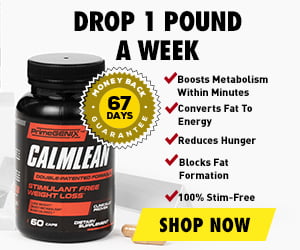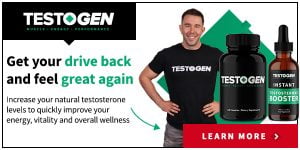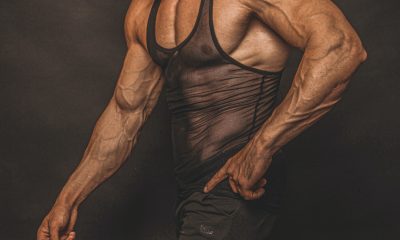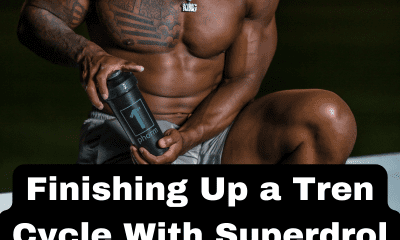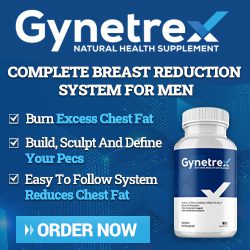Recovery
Post Cycle Therapy Vs. B&C: Which is Best for You?
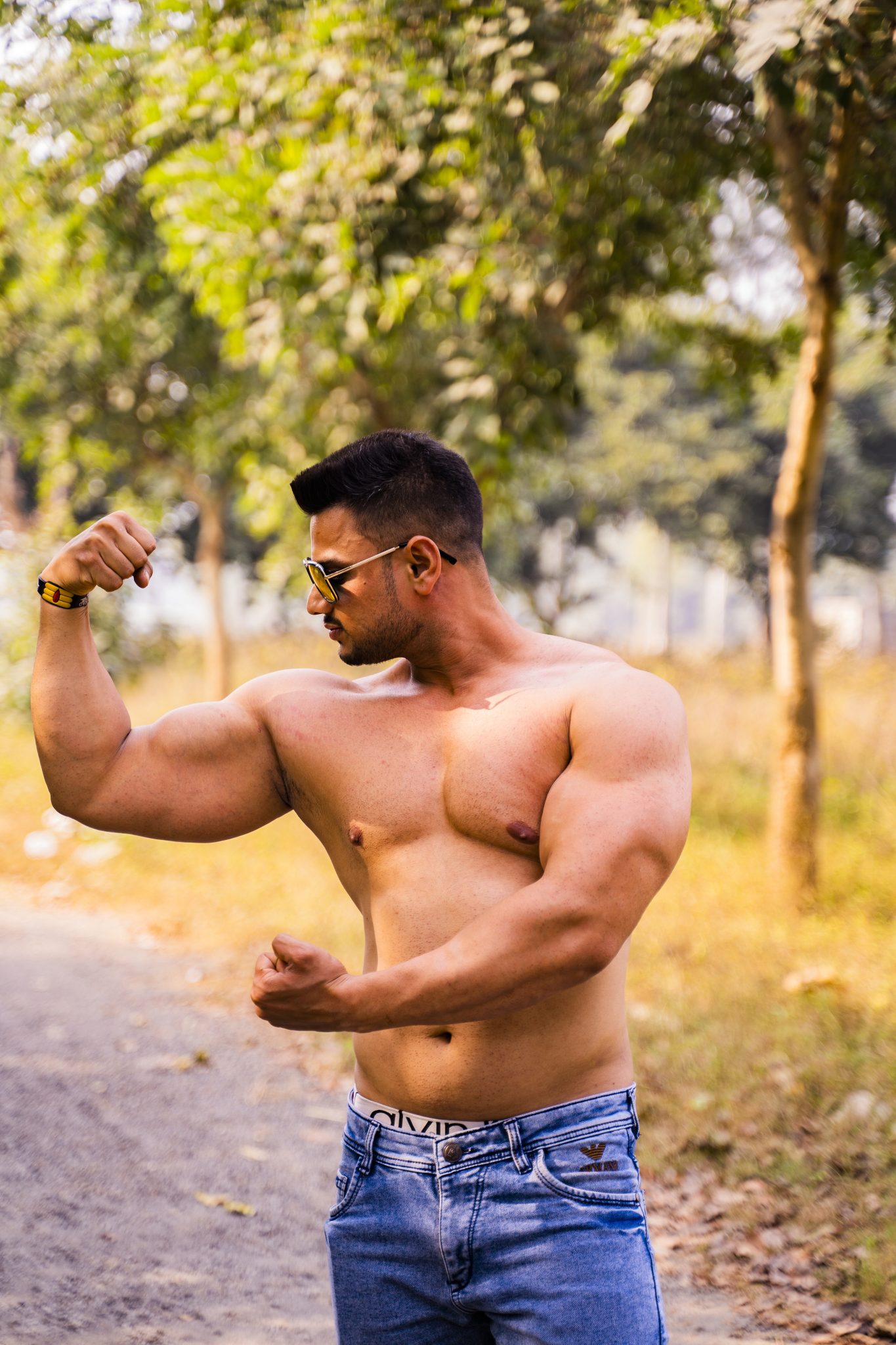
There has been a heated debate among bodybuilders about Post Cycle Therapy (PCT) and Blast and Cruise (B&C). Even as we aim to choose the best between the two, it is essential to note that what works for someone else may not always work for you. Whether to go PCT or B&C is determined by certain factors, and most of them are beyond your control. For instance, old age and physique are significant determinants of choosing the technique. But first, what do you understand by the terms PCT and B&C? Well, we will explain them in this article and hopefully help you pick the best for your current physique.
Bodybuilder PCT
You must have come across this term if you’re a seasoned bodybuilder. For those who might not have heard of it, PCT is a recovery and self-care technique bodybuilders, and other athletes use to overcome a steroid cycle. Its primary purpose is to help the body to adapt to its new form after a successful cycle. There are no significant changes in body weight while on PCT, even when the diet is changed. Considered the most body-friendly, PCT is commonly used by beginners unable to adapt to post-cycle changes immediately. However, bodybuilding pros still use the strategy after coming off cycling or changing from one cycle to another.
As you may be aware, coming off a cycle is easy and challenging at the same time. This option is usually for those who want to come out as fast as possible without taking a toll on them. Although considered an option for ‘weaklings’, PCT has helped many would-be champions keep their form. The myth is that people who blast do not PCT well, but that is entirely misguided. On the contrary, some bodybuilders have succeeded in alternating the two rather than going with one. It all comes down to what you can or cannot handle.
Must Read:: All About Post-Steroid Cycle Therapy
Blast and Cruise
Blast and Cruise is a term used to refer to an initial increase and then decrease in cycle dosage instead of coming off steroids altogether. Blasting involves taking a certain Xmg of a steroid for a fixed period, say four weeks, while cruising is taking (X-Y) mg of the steroid for the next four weeks. For instance, if you blast 500mg of tren and 1000mg of another steroid for five weeks, you should cruise only 500mg for the next 10 weeks. The cycle should be repeated for as long as necessary, each time adding or dropping a particular drug when blasting and not necessarily altering cruising.
However, the time for blasting and cruising may differ depending on the bodybuilder’s preference and the type of steroids. Similarly, there is no fixed dosage for a particular steroid while blasting or cruising; it depends on how your body responds to the cycle. While most bodybuilders prefer keeping it proportional, some would want to use different steroids to blast while maintaining only one for cruising. Additionally, pro bodybuilders usually make a blast and cruise proportional all year round, irrespective of the steroid combination. Most importantly, it is only considered a blast and cruise if someone uses testosterone to cruise. The type of steroids one uses to blast doesn't matter, but a successful B&C must use testosterone as the base. Bodybuilders who have tried to deviate from this rule have found it challenging to achieve their cycle goals.
Advantages of Bodybuilder PCT
Post-cycle therapy has several advantages if you know what you're doing. Our research has revealed that this technique works best for upcoming bodybuilders not used to cycling. Here are some benefits one stands to get by using PCT.
- There are no significant changes in body weight, so one doesn't have to alter their diet.
- It is much easier on your body.
- It promotes natural bodybuilding, thus reducing the chances of one getting hooked on steroids.
- One can avoid nasty side effects associated with prolonged use of steroids.
- It allows one to reach their limit by promoting natural muscle growth.
- It may make your bodybuilding career a bit cheaper without regular jabbing
- It leads to better consolidation of gains as there is little impact on the body's hormonal balance.
- The risk of infertility from steroid use is reduced significantly.
Related Article:: What is PCT and Why It’s so Important in Steroid Cycles
Disadvantages of Bodybuilder PCT
Critics of post-cycle therapy for recovery have cited several reasons they might never attempt it. While we may not independently verify those claims, you must consult widely before deciding. Your doctor or personal trainer could be the best person to guide you accordingly. Here are the known cons of PBCT.
- Recovery is not always guaranteed, so cycling may not result in any benefits despite investing time and resources.
- It is considered a technique for bodybuilders who don’t have the balls to keep jabbing.
- It may not work if one has gotten used to using steroids over a long period.
- Recovery might take longer than expected, throwing one into a physical and psychological crisis.
- It does not work well with aging bodybuilders.
- It is associated with too much blues, which few people can cope with.
Advantages of B&C
- One has lesser chances of undergoing physical and mental deterioration.
- Cruising after blasting allows the body to normalize its functions and get you back on track as soon as possible.
- Cruising prevents permanent damage to vital organs. If anything, such organs have been found to perform more than usual.
- Faster progress is made compared to PCT.
Disadvantages of B&C
Although many bodybuilders prefer getting the jab for their entire lives and career, B&C comes with certain disadvantages you need to know about.
- The gains decrease significantly as one continues using steroids. It is because steroids, unlike amphetamines, do not increase their effect on the body when the dosage is increased. The result is that the body demands more but without an impact.
- Increased risk of the permanent shutdown of natural testosterone as one continues using high doses of steroids.
- If the body develops tolerance to steroids, it may lead to partial recovery, which isn't good from a clinical point of view. Furthermore, partial recovery is considered to be worse than PCT blues, which most bodybuilders fear.
- It may permanently damage vital organs if cruising is not done correctly. That is because steroid doses in B&C are administered consistently above the psychological range.
- The risk for infertility is higher because the steroids not only reduce your sex drive but may also cut down the user’s sperm count.
Similarities
It is fair enough to say that PCT and B&C are more or less the same, depending on how one views it. For instance, someone who does a 24-week cycle may consider it to be B&C, while in fact, it is just a long cycle. In this case, the cycle may serve as a PCT for a young bodybuilder and a B&C for another nearing retirement. Some people don’t intend to recover, so they assume they’re blasting and cruising. However, without adhering to the proper way of B&C, that could not be considered as such.
Choosing the Best Strategy Bodybuilder PCT for You
Going PCT or B&C is a personal choice, but you could use advice. First, everyone has their goals concerning their physical appearance, and they can't be stopped until they achieve them. That is quite positive, but you must not be too blinded by the goals to bypass certain precautions. Before you decide on your cycling technique, consider your body’s unique needs.
Ask yourself whether you're doing this to win titles or to feel good about your body. If the former is your motivation, we recommend the PCT route. The reason for this is simple; you have a lot to do with your life once the physique farce is gone. Trust me; you don’t want to spend the rest of your life regretting the choices you made in this regard. Only choose B&C if you’re convinced that is what you want and ready to do it for the rest of your life. Most importantly, listen to your body and do exactly what it wants. Weigh the pros and cons of the two techniques and see if it is something you can handle.
Overall
Bodybuilder PCT and B&C will help you come off a steroid cycle and use them permanently, but one has to do it right. Be honest with yourself about what you want before settling on either method. Also, note that using anabolic and androgenic steroids (AAS) in fitness and bodybuilding will last a long. However, the use of AAS is regulated and unregulated in equal measure. While we advocate the safe use of steroids, Whatsteroids.com does not advocate the unlawful use, possession, and supply of prohibited substances. Please visit our shop to find genuine, high-quality steroid products to help your cycling.
Bodybuilding
Cellular Alchemy to Restore Testosterone Levels

The convergence of stem cell therapy and hormone regulation represents an intriguing frontier in medical research, especially regarding the possibility of enhancing testosterone levels. In this article, we shall explore cellular Alchemy from a bodybuilding perspective.
Testosterone, the essential male hormone, plays a crucial role in various bodily functions, including muscle mass maintenance, bone density, and mood regulation. As men age, natural declines in testosterone levels can lead to hypogonadism, significantly affecting their quality of life.
Stem cell therapy or cellular Alchemy offers a promising avenue for restoring testosterone levels, even in bodybuilders. Let’s delve into the details:
Background on Testosterone and Hypogonadism
Testosterone is crucial for male sexual development, cognitive function, and overall health.
As men age, testosterone levels naturally decline, leading to conditions like hypogonadism (abnormally low testosterone).
Hypogonadism can cause mood disturbances, reduced sex drive, and weakened muscle and bone strength.
Traditional Approach: Testosterone Replacement Therapy (TRT)
The common clinical approach is testosterone replacement therapy (TRT).
However, TRT has significant side effects, including venous thromboembolism and deep vein thrombosis.
Stem Cell Research and Alternative Treatment
Recent stem cell research suggests an alternative treatment: directly transforming adult skin cells into testosterone-producing cells.
Leydig cells in the testicles naturally produce androgens, which are then converted into testosterone.
Scientists have explored creating Leydig-like cells using direct cell reprogramming.
In rodents with hypogonadism, researchers transplanted these reprogrammed cells to boost testosterone production.
Must Read: Muscle Disorders: Diagnosis, Treatment and Coping Routine
Implications for Bodybuilders
Stem cell therapy could benefit bodybuilders by:
Enhancing muscle growth: Stem cells may stimulate muscle repair and regeneration.
Improving recovery: Faster recovery after intense workouts.
Alleviating symptoms: Reduced libido, fatigue, and muscle loss associated with low testosterone.
Stem cell therapy for testosterone restoration is an exciting field, but it’s essential to understand both its potential benefits and risks. Let’s explore:
Testosterone Replacement Therapy (TRT) Risks
TRT is the common clinical approach for hypogonadism (low testosterone).
However, TRT has notable side effects, including:
Increased risk of blood clots: TRT can lead to elevated red blood cell production, potentially causing blood clots.
Sleep apnea risk: Some individuals on TRT may experience interrupted breathing during sleep.
Testicular atrophy: The testicles may shrink due to TRT.
Prostate growth: Regular prostate cancer monitoring becomes necessary.
Stem Cell Therapy Approach
Recent research explores an alternative: directly transforming adult skin cells into testosterone-producing cells.
Scientists aim to create Leydig-like cells using direct cell reprogramming.
Leydig cells in the testicles naturally produce androgens, which then convert into testosterone.
In rodent studies, researchers transplanted these reprogrammed cells to boost testosterone production2.
Implications and Caution
Stem cell therapy shows promise, but it’s still experimental.
Risks associated with stem cell therapy are not fully understood.
Safety, efficacy, and long-term effects need further investigation.
Cellular Alchemy Success Rate
Stem cell therapy for testosterone restoration shows promising results, particularly in the context of male hypogonadism. Let’s explore the success rates based on recent research:
Background on Male Hypogonadism
Male hypogonadism is characterized by abnormally low testosterone levels.
It can lead to mood disturbances, reduced sex drive, and decreased muscle and bone strength.
Approximately 30% of older men are affected by this condition.
Common Clinical Approach: Testosterone Replacement Therapy (TRT)
TRT is the standard treatment for hypogonadism.
However, TRT has significant side effects, including venous thromboembolism and deep vein thrombosis.
Stem Cell Research and Leydig-Like Cells
Scientists have explored an alternative using stem cells.
They directly transform adult skin cells into Leydig-like cells, which produce androgens and then biosynthesize testosterone.
In rodent studies, these reprogrammed Leydig cells were transplanted into testosterone-deficient animals.
Remarkably, the cells survived and restored normal testosterone levels in males with hypogonadism.
Success Rate
While individual outcomes may vary, stem cell therapy has shown promise.
Success rates are not universally defined, but the approach offers an exciting alternative to androgen replacement therapy.
Related Article: First Injectable Steroid Cycle
Holistic Approach to Men’s Health
Research Progress: As scientific knowledge advances, we recognize that health interventions should consider the whole person, not just isolated aspects.
Stem Cell Therapy: This emerging field offers potential benefits for various health conditions, including hypogonadism (low testosterone).
Holistic View: Rather than focusing solely on stem cell therapy, we should integrate it into a broader approach that considers lifestyle factors.
Lifestyle Factors and Testosterone
Diet: Proper nutrition is crucial. Certain nutrients (like zinc and vitamin D) support testosterone production.
Exercise: Regular physical activity, especially resistance training, positively influences testosterone levels.
Stress Management: Chronic stress can lower testosterone. Techniques like meditation and relaxation help maintain hormonal balance.
Complementary Role of Stem Cell Therapy
Enhancing Well-Being: Stem cell therapy complements lifestyle efforts.
Managing Hypogonadism: It can address testosterone deficiency, but it’s not a standalone solution.
Synergy: Combining stem cell therapy with lifestyle changes creates a comprehensive strategy.
Overall Health: This approach benefits not only testosterone levels but also overall health and vitality.
Viewing stem cell therapy holistically involves integrating it with lifestyle choices, creating a synergistic approach to men’s health.
Dietary Recommendations to Support Cellular Alchemy
 Buy Cabaser 1 mg [20 Tabs, Pfizer]
Buy Cabaser 1 mg [20 Tabs, Pfizer]
When it comes to managing hypogonadism, dietary choices play a crucial role. Here are some dietary recommendations:
Nutrient-Rich Foods
Zinc: Include foods like oysters, beef, pumpkin seeds, and legumes. Zinc supports testosterone production.
Vitamin D: Fatty fish (salmon, mackerel), fortified dairy products, and sunlight exposure help maintain healthy levels.
Healthy Fats: Avocado, nuts, and olive oil provide essential fats for hormone synthesis.
Avoid Excessive Alcohol and Sugar
Alcohol can negatively impact testosterone levels.
High sugar intake may lead to insulin resistance, affecting hormonal balance.
Protein Intake
Adequate protein supports muscle growth and overall health.
Include lean meats, eggs, and plant-based protein sources.
Anti-Inflammatory Foods
Chronic inflammation can affect testosterone.
Consume fruits, vegetables, and whole grains to reduce inflammation.
Natural Alternatives to Cellular Alchemy
If you’re looking for natural ways to boost testosterone without relying on cellular alchemy, consider the following strategies:
Ashwagandha Supplement
Ashwagandha, an adaptogenic herb, has been linked to reduced stress and increased testosterone levels.
In studies, it improved muscle strength and testosterone in men who took 600 mg daily for eight weeks.
Note that it didn’t have the same effect on women.
Prioritize Sleep
Aim for 7-9 hours of quality sleep each night.
Lack of sleep can lower testosterone levels, so prioritize rest.
Optimize Vitamin D
Vitamin D deficiency is associated with low testosterone.
Get sunlight exposure or consider supplements if needed.
Dietary Choices
Certain foods can help raise testosterone:
Grass-fed beef: Rich in nutrients and healthy fats.
Zinc-rich foods: Oysters, beef, and pumpkin seeds.
Vitamin D sources: Fatty fish and fortified dairy products.
Keep in mind that a holistic approach that combines lifestyle changes, nutrition, and natural supplements can contribute to maintaining healthy testosterone levels. Always consult a healthcare professional for personalized advice.
Overall
As a general recommendation, we advise caution regarding cellular alchemy. While it shows promise for testosterone restoration, it remains experimental. Consult a healthcare professional before considering it. For bodybuilders, natural alternatives (like lifestyle changes and supplements) are safer and more widely applicable.
Also Read: Meet the World’s Strongest Grannies
Bodybuilding
Here Is How To know Your MRV (Maximum Recoverable Volume)
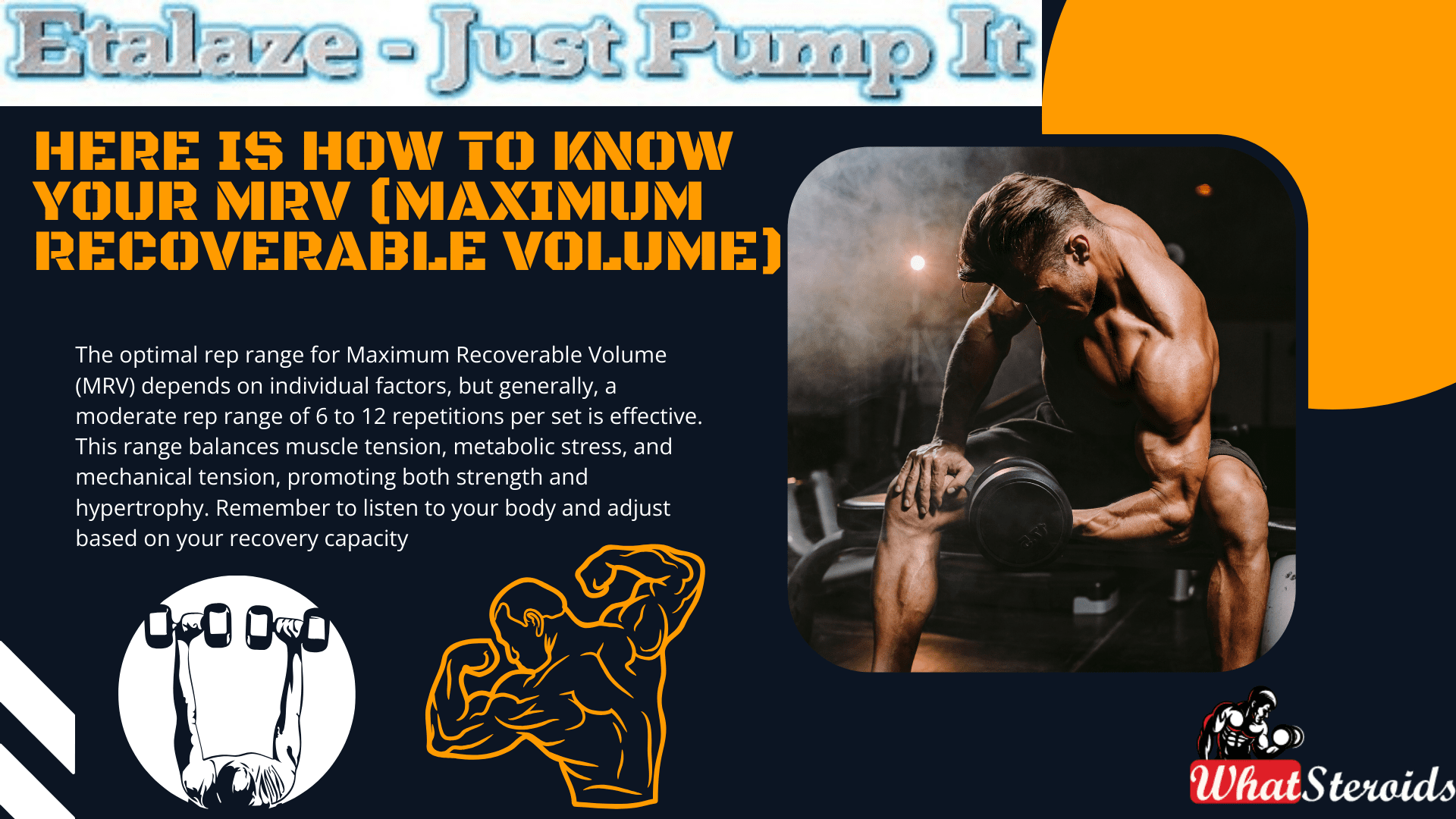
MRV (Maximum Recoverable Volume) refers to the highest training volume an individual can handle while still making progress. It’s a personalized threshold that considers sets, reps, and intensity within a given period (usually a week).
Don't Miss: Best Creatine Pills vs. Powder – Pros and Cons of Both Forms
Exceeding MRV can lead to overtraining, causing fatigue, performance decline, and injury risk. Progressive overload is key, but staying below MRV ensures sustainable gains.
The optimal rep range for Maximum Recoverable Volume (MRV) depends on individual factors, but generally, a moderate rep range of 6 to 12 repetitions per set is effective. This range balances muscle tension, metabolic stress, and mechanical tension, promoting both strength and hypertrophy. Remember to listen to your body and adjust based on your recovery capacity.
Factors That Determine MRV
Here’s a concise breakdown of the factors influencing an individual’s Maximum Recoverable Volume (MRV):
Hormonal Environment
Hormone levels (endogenous or exogenous) impact recovery speed and MRV.
Higher hormone levels correlate with better recovery and a higher MRV.
Nutrition
Adequate macronutrient intake (especially protein) affects recovery and MRV.
Proper nutrition supports muscle repair and capacity for higher training volumes.
Training Experience
Beginners have a lower MRV due to unfamiliarity with high training volumes.
Advanced athletes, with more training years, usually have a higher MRV.
Age
Younger athletes tend to have a higher MRV due to better recovery abilities.
As athletes age, recovery slows down, reducing MRV.
Sleep
Adequate sleep is essential for recovery. Lack of sleep can negatively impact your MRV.
Genetics
Genetic factors also contribute. Some individuals naturally have a higher MRV than others.
Must Read: Horse Chestnut and Other Supplements to Get Rid of Water Retention
Better Ways to Improve Your MRV
Let’s explore ways to enhance a bodybuilder’s Maximum Recoverable Volume (MRV) for optimal muscle growth.
Gradual Volume Progression: Increase training volume gradually over time. Monitor recovery and adjust accordingly.
Personal Volume Landmarks: Understand your individual MRV. Experiment with weekly sets and track recovery.
Balanced Stimulus-Fatigue Ratio: Optimize exercise-specific stimulus while managing fatigue.
Quality Over Quantity: Focus on effective reps and quality sets rather than excessive volume.
Periodization: Vary training volume across mesocycles (e.g., high, moderate, low volume phases).
Frequency: Spread volume across multiple sessions per week for better recovery.
Compound Movements: Prioritize compound exercises for efficient volume utilization.
Rest Intervals: Adjust rest times to balance fatigue and performance.
Nutrition and Sleep: Support recovery with proper nutrition and adequate sleep.
Deload Weeks: Regularly incorporate lighter training weeks to manage fatigue.
Auto-Regulation: Listen to your body and adjust volume based on daily readiness.
Supplement Timing: Use supplements (e.g., creatine, BCAAs) strategically to aid recovery.
Active Recovery: Include light activities (e.g., walking, swimming) on rest days.
Mind-Muscle Connection: Focus on muscle contraction during each set.
Intra-Workout Nutrition: Consider BCAAs or carb-based drinks during training.
Variety: Rotate exercises to prevent staleness and optimize volume.
Warm-Up Sets: Gradually ramp up intensity to avoid sudden volume spikes.
Individual Recovery Factors: Consider stress levels, age, and lifestyle.
Volume Cycling: Periodically reduce volume to enhance recovery capacity.
Systemic MRV: Prioritize muscle groups based on overall recovery capacity.
Note that individual responses vary, so adjust these strategies based on your unique needs.
Deloading Phases to Increase Your Chances of Success
Deloading phases, also known as deload weeks, are strategically planned periods of reduced training intensity and volume. They serve several purposes in a well-structured training program.
Recovery and Adaptation
Deloading allows your body to recover from accumulated fatigue caused by intense training.
During deloads, you reduce the stress on muscles, joints, and the nervous system.
This recovery time helps prevent overtraining and promotes adaptation.
Performance Enhancement
After a deload, you often experience improved performance due to better recovery.
Strength, power, and endurance may increase as your body adapts to the previous workload.
Mental Refreshment
Deloads provide a mental break from heavy training.
They prevent burnout and maintain motivation by preventing staleness.
How to Implement Deloads
Frequency: Deloads typically occur every 4-8 weeks, depending on your training intensity and individual needs.
Volume Reduction: Decrease training volume (sets, reps, or both) by about 40-60% during the deload week.
Intensity: Maintain intensity (weight lifted) but reduce overall workload.
Focus on Form and Technique: Use the deload week to fine-tune your lifting technique.
Cardio and Mobility: Include light cardio and mobility work to promote blood flow and flexibility.
For instance, if you’ve been lifting heavy weights, reduce the weight and perform fewer sets and reps.
For endurance athletes, decrease mileage or intensity during deload weeks.
Deloading is individualized. Listen to your body, assess your recovery needs, and adjust the deload parameters accordingly.
Is It Possible to Measure MRV?
We have seen that MRV is a critical concept for optimizing muscle growth. But can you measure it accurately? Here are some methods to determine your MRV:
Trial and Error Approach: Gradually increase your weekly training volume (sets and reps) over several weeks. Monitor your recovery and performance. When you notice a decline in performance or recovery, you’ve likely reached your MRV.
Incremental Volume Increase: Start with a relatively low work volume (fewer sets per muscle group) at the beginning of a training cycle. Add 1-2 sets per muscle group each week. Observe when performance starts to dip, as that indicates your MRV.
Overall
In summary, the concept of Maximum Recoverable Volume (MRV) holds immense significance for those aiming to optimize their training routines for muscle growth and overall performance.
By delving into the intricacies of MRV and respecting its boundaries, you can safely push their limits, ensuring consistent progress while minimizing the risk of overtraining. The dynamic nature of MRV, influenced by multifaceted factors such as training experience, age, hormonal balance, nutrition, quality of sleep, and genetic predisposition, underscores the value of personalized training programs.
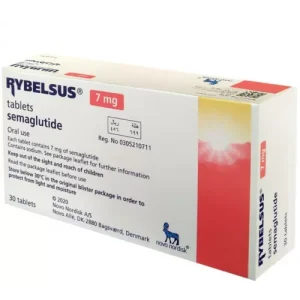 Click Here to Buy Rybelsus Semaglutide Tablets
Click Here to Buy Rybelsus Semaglutide Tablets
Regularly assessing and fine-tuning training volume allows bodybuilders to unlock their full potential in their fitness endeavors. While other variables certainly matter, training volume remains a pivotal factor in achieving fitness goals efficiently and effectively.
Related Article: Top 10 Erection Gels & Creams for Him
Bodybuilding
Demystifying Hypertrophy Training
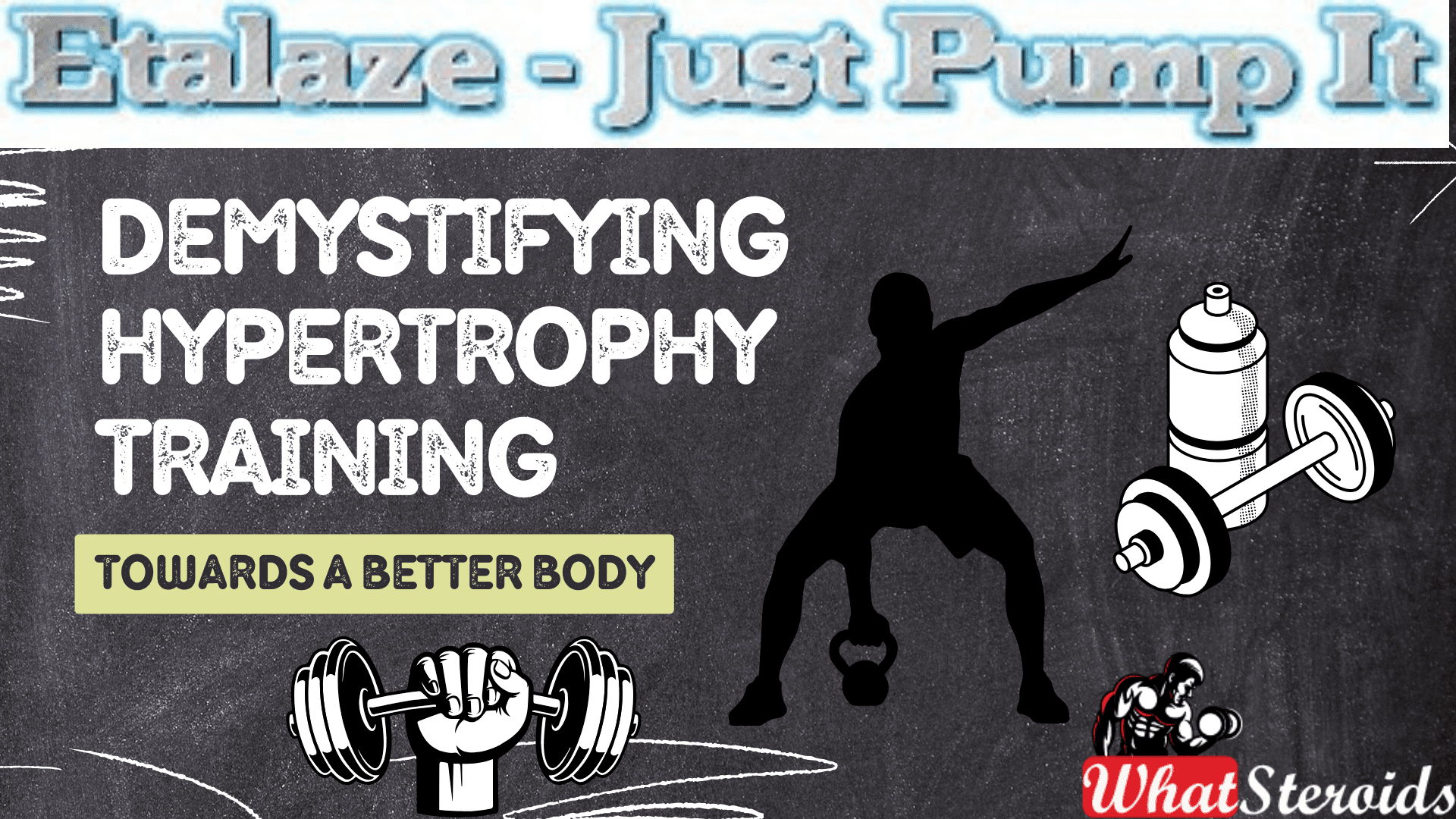
Hypertrophy training, often referred to as bodybuilding training, is a method focused on increasing muscle size and definition through targeted exercises and specific training techniques. Professional bodybuilders have mastered the art of hypertrophy training to sculpt their bodies into peak physical condition.
At its core, hypertrophy training involves lifting weights at a moderate to high intensity for a moderate number of repetitions. The goal is to create micro-tears in the muscle fibers, which then repair and grow stronger and larger during the recovery process. This leads to muscle hypertrophy or an increase in muscle size.
Understanding the basics of hypertrophy training involves knowing how to manipulate variables such as sets, reps, rest periods, tempo, and intensity. By adjusting these factors, individuals can tailor their workouts to target specific muscle groups and achieve optimal results.
Proper nutrition and adequate rest are also crucial components of hypertrophy training as muscles need sufficient fuel and time to recover and grow. Consistency in training and adherence to a well-rounded program are key pillars in unlocking the full potential of hypertrophy training.
Must Read: The Ultimate Chain and Plate Curls for Pumping Biceps
By demystifying hypertrophy training and embracing its principles with dedication and focus, individuals can effectively work towards achieving their desired physique goals while enhancing overall strength and endurance.
Principles of Hypertrophy Training
When you engage in strength training, you put strain on your muscles. This stress prompts the body to repair and adapt, resulting in an increase in muscle fibers. Here are the basics about this form of training you need to familiarise with:
Training Frequency
For new bodybuilders, a frequency of 3-4 times per week is often recommended to allow for sufficient recovery between sessions. Professional bodybuilders may train more frequently, sometimes up to 5-6 times per week, as their bodies have adapted to higher training volumes over time.
Intensity and Volume: New bodybuilders typically start with moderate intensity (around 65-75% of their one-rep max) and moderate volume (3-4 sets of 8-12 reps per exercise). Professional bodybuilders often incorporate higher intensities (75-85% of one-rep max) and higher volumes (4-6 sets of 8-15 reps per exercise) to continue stimulating muscle growth.
Exercise Selection
Both new and professional bodybuilders focus on compound exercises (e.g., squats, deadlifts, bench press) that target multiple muscle groups simultaneously to maximize muscle recruitment and overall hypertrophy. However, professionals may incorporate more isolation exercises to target specific muscles or muscle groups that need extra attention.
Progressive Overload
Both groups prioritize progressive overload, which involves gradually increasing the weight, reps, or sets over time to continue challenging the muscles and promoting growth. This can be achieved through methods such as increasing resistance, shortening rest periods, or varying exercise techniques.
Nutrition
Both new and professional bodybuilders emphasize the importance of nutrition for muscle growth and recovery. This includes consuming an adequate amount of protein to support muscle repair and synthesis, as well as sufficient carbohydrates and fats for energy and overall health.
Rest and Recovery
Adequate rest and recovery are crucial for hypertrophy training. Both new and professional bodybuilders prioritize getting enough sleep (7-9 hours per night) and incorporating rest days into their training schedules to allow muscles to repair and grow.
Supplementation
While both new and professional bodybuilders may use supplements to support their training and nutrition goals, professionals may have more sophisticated supplementation protocols tailored to their specific needs and goals. We recommend supplements such as protein powders, creatine, branched-chain amino acids (BCAAs), and pre-workout formulas.
Monitoring and Adjustments
Professional bodybuilders often closely monitor their progress through measurements such as body weight, body composition, and strength levels. Based on these assessments, they make adjustments to their training, nutrition, and supplementation protocols to continually progress towards their goals.
Arnold Schwarzenegger's Hypertrophy Workout Routine
Arnold Schwarzenegger's volume workout is a legendary approach to hypertrophy training that he popularized during his bodybuilding career. Here's an explanation of how his workout relates to hypertrophy training:
High Volume
Schwarzenegger's training program was characterized by high volume, involving a large number of sets and reps per workout. This high volume stimulates muscle growth by subjecting the muscles to prolonged tension and metabolic stress, both of which are key factors in hypertrophy.
Multiple Sets and Reps
Each exercise in Schwarzenegger's workout typically included multiple sets (often 4-5 sets) with a moderate to high number of reps (8-12 reps). This approach allows for ample time under tension, which is essential for stimulating muscle growth and hypertrophy.
Compound and Isolation Exercises
Schwarzenegger's workout included a combination of compound exercises (e.g., squats, bench press, deadlifts) and isolation exercises (e.g., bicep curls, tricep extensions) to target various muscle groups from different angles. Compound exercises help to maximize muscle recruitment, while isolation exercises allow for targeted muscle stimulation and hypertrophy.
Frequency
Schwarzenegger typically trained each muscle group 2-3 times per week, allowing for sufficient frequency to stimulate muscle growth while also providing adequate recovery time between sessions. This frequency helps to maximize hypertrophy by consistently exposing the muscles to growth-inducing stimuli.
Intensity Techniques
Schwarzenegger often incorporated intensity techniques such as drop sets, supersets, and forced reps into his workouts to further increase the intensity and stimulate muscle growth. These techniques help to push the muscles beyond their normal limits, triggering adaptations that lead to hypertrophy.
Periodization
Schwarzenegger employed periodization principles in his training, alternating between phases of higher volume and lower volume to prevent plateaus and continue making progress. This periodization strategy helps to optimize muscle growth by varying training stimuli over time.
Mind-Muscle Connection
Schwarzenegger emphasized the importance of the mind-muscle connection, focusing on contracting and feeling the target muscles working during each repetition. This approach helps to maximize muscle fiber recruitment and engagement, enhancing the effectiveness of each exercise for hypertrophy.
Nutrition and Recovery
In addition to his training program, Schwarzenegger paid close attention to his nutrition and recovery strategies to support muscle growth and hypertrophy. Adequate protein intake, proper hydration, and sufficient rest are essential components of any hypertrophy-focused training program.
Overall, Schwarzenegger's volume workout is a comprehensive approach to hypertrophy training that incorporates high volume, frequency, intensity techniques, and periodization to maximize muscle growth and achieve an impressive physique.
Also Read: Why Trenbolone Remains A Beast In The Market
10 Groups of Athletes That Can Benefit from Hypertrophy Workouts
We have prepared for you 10 groups of athletes that should consider hypertrophy training
1. Combat Sports Athletes
Martial artists, boxers, and other combat sports athletes can enhance their power and endurance through hypertrophy training.
2. Track and Field Athletes
Sprinters, jumpers, and throwers can improve their explosive strength by including hypertrophy training in their regimen.
3. Football/Soccer Players
Both American football players and soccer players can benefit from hypertrophy training to increase muscle mass and strength.
4. Gymnasts
Building lean muscle mass through hypertrophy training can help gymnasts improve their strength-to-weight ratio for better performance.
5. Swimmers
Swimmers can enhance their power in the water by incorporating hypertrophy exercises to strengthen key muscle groups.
6. Cyclists
While endurance is crucial for cyclists, adding hypertrophy training can boost leg strength and overall performance on the bike.
7. Basketball Players
Building muscle through hypertrophy training can improve basketball players' agility, jumping ability, and overall athleticism on the court.
8. CrossFit Athletes
CrossFit enthusiasts looking to excel in competitions can benefit from hypertrophy training to increase overall strength and muscular endurance.
9. Triathletes
Incorporating hypertrophy exercises into triathletes' routines helps prevent injuries by strengthening muscles that support joints during long-distance races.
10. Powerlifters
While powerlifting focuses on maximal strength lifts, including some hypertrophy work can aid in building a solid muscular foundation for lifting heavy weights more efficiently.
By tailoring a specific hypertrophy program to suit each group's athletic needs and goals, these athletes have the opportunity to optimize their performance levels while reducing the risk of injury associated with repetitive movements in sports-specific activities.
Final Thoughts
By understanding the underlying principles of progressive overload, volume, intensity, and frequency, individuals can tailor their training programs to effectively stimulate muscle growth. Whether you're a novice or a seasoned athlete, hypertrophy training offers a structured framework for optimizing muscle hypertrophy and sculpting a physique that reflects dedication, consistency, and strategic planning.
Embracing the science behind hypertrophy training empowers you as an individual to surpass limitations, break plateaus, and unlock their full potential in pursuit of their fitness aspirations. With proper guidance, commitment, and perseverance, anyone can harness the transformative power of hypertrophy training to sculpt a stronger, more resilient, and aesthetically pleasing physique.
Related Article: Post Cycle Therapy Vs. B&C: Which is Best for You?
-

 Bodybuilding2 years ago
Bodybuilding2 years agoNew Arrival Workout Equipment on Amazon for The Disabled
-

 Steroids2 years ago
Steroids2 years agoSupplemental Breast Milk for Bodybuilders: The Secret Behind It
-

 Steroids2 years ago
Steroids2 years agoDwarf Bodybuilders Giving Pros A Run for Their Money
-

 Steroids1 year ago
Steroids1 year agoVOX Testing: Why Bodybuilders Must Have It Tested Regularly
-

 Steroids1 year ago
Steroids1 year agoShavers and Other Body Grooming Equipment for Bodybuilders In 2023
-

 Steroids1 year ago
Steroids1 year agoChatGPT and Other Avenues to Find Great Bodybuilding Coaches
-

 Steroids1 year ago
Steroids1 year agoBest Oil Recommendations Before Competition for Subtle Shimmer
-

 Steroids1 year ago
Steroids1 year agoPowerlifting Vs Power Building: Find Out the Big Difference and When to Shift Between the Two
-

 Beginners12 months ago
Beginners12 months agoTren Cycle for Beginners
-

 Bodybuilding11 months ago
Bodybuilding11 months agoCompetition Prep Cycle for Pro Bodybuilders
-

 Nutrition9 months ago
Nutrition9 months agoEverything Nutritional Food: What’s Too Much Or Too Little
-

 Anabolic Steroids8 months ago
Anabolic Steroids8 months agoLegality of Anabolic Steroids In Latin America
-

 Bodybuilding8 months ago
Bodybuilding8 months agoChia Seeds in A Bodybuilder’s Diet: An Expert’s Advice
-

 Bodybuilding6 months ago
Bodybuilding6 months agoList of FDA-Approved Peptides
-

 Anabolic Steroids7 months ago
Anabolic Steroids7 months agoStart The New Year Strong With These Tips
-

 Anabolic Steroids9 months ago
Anabolic Steroids9 months agoNatural Steroids for Bodybuilding
-

 Beginners9 months ago
Beginners9 months agoCalisthenics: Secret to Building A Better Upper and Middle Body
-

 Bodybuilding7 months ago
Bodybuilding7 months agoUnique Things That Have Redefined Mr Olympia Over The Years
-

 Steroids5 months ago
Steroids5 months agoTrenbolone: Why it Remains A Beast In the Market
-

 Bodybuilding Products4 months ago
Bodybuilding Products4 months agoTelmisartan In Bodybuilding: An Expert’s Advice
-

 Bodybuilding5 months ago
Bodybuilding5 months agoThe Importance of Scaptions in Female Athletes
-

 Bodybuilding4 months ago
Bodybuilding4 months agoHow Much Is Too Much Cardio? Understanding Heart Rate Zones
-

 Bodybuilding6 months ago
Bodybuilding6 months agoFunny Gym Stories and Moments to Light Up Your Day
-

 Steroids8 months ago
Steroids8 months agoThese Bodybuilding Equipment Might Become Obsolete Next Year (See Alternative Upgrades)
-

 Bodybuilding7 months ago
Bodybuilding7 months agoCalorie Dumping: A Bodybuilder’s Guide

